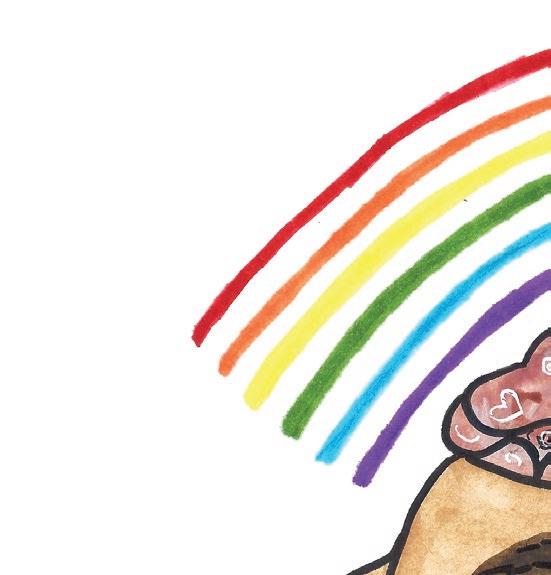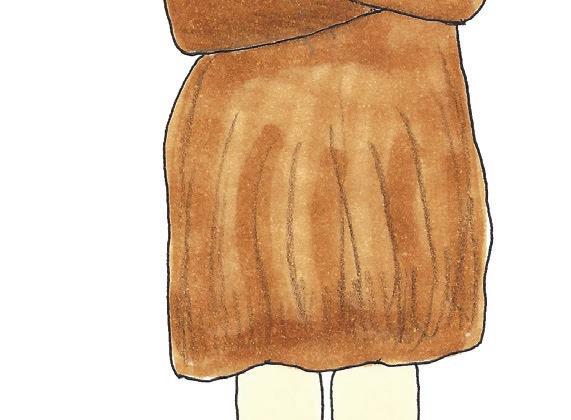
6 minute read
why PRIDE?
from Guide for Pride
by MKC Maribor
Celebration vs. Protest
Generally speaking, pride parades have various meanings for people in diff erent cities and countries. They oft en serve as global examples promoting the human rights initiative, but Pride as a concept also has an individual value, so its existence has numerous reasons. Many see it as a celebration of diversity and self-acceptance, but originally it started as a protest in the fi ght for equality of the LGBTQIA+ community. When organizing our fi rst parade, an important question was raised: which of these is the “right” way? Do we want to protest and take a political stand? Or do we want to promote and celebrate the ideas of acceptance and inclusion in the LGBTQIA+ community and beyond?
Advertisement

The answer is that we shouldn’t exclude either of the two aspects, which can’t be fully separated in the fi rst place. In other words, the concepts of celebration, protest, as well as promoting greater visibility of the LGBTQIA+ community and raising awareness about its problems will always intertwine. The question of how these aspects interact in specifi c cases depends mostly on the environment where the pride parade is being organized. Countries and cities around the world have diff erent laws and mindsets regarding LGBTQIA+ issues. Because circumstances diff er from place to place, there can be no single right answer. Organizers need to understand the local communities and their needs, including nonLGBQTIA+ individuals, as well as other unique factors.
Any pride parade can be, will be and, to a degree, has to be provocative because of its role of creating change in an unequal society. It’s still important to fi nd a balance between raising awareness and claiming our rights and not pushing boundaries in disrespectful ways. What could some of those boundaries be? When we talk about LGBTQIA+ topics, we oft en center them around sex and sexuality. How could we not? Those aspects are hard to ignore when discussing diff erent sexual and romantic orientations and gender identities.

why PRIDE?
However, many people, cultures and communities have restrictions and reservations regarding sexuality in general. In conservative environments, sex is not a widely discussed topic and is still considered taboo even in conversation, oft en seen as something shameful and sinful as opposed to societies that view it as a natural part of humanity experienced in one’s own unique way. Furthermore, communication and education on the topic of sexuality are lacking. With that in mind, it’s not hard to understand why anti-LGBTQIA+ prejudice persists. It’s oft en because people are uncomfortable talking about sexuality in general, even in terms of heteronormativity.
In communities that are less open to these issues, pride parades have to emphasize LGBTQIA+ rights as human rights, as well as the general importance of equal rights regardless of sexual orientation, gender identity, skin color, nationality or religion. The LGBTQIA+ community embraces individual sexualities and every form of sexual expression where all individuals are in a consensual agreement.
Equality ≠ Equity
What is equity?
The definition of equity is the quality of being fair and impartial. It means giving someone what they need instead of everyone getting the same treatment.
Do people from the LGBTQIA+ community have the same level of equity as other people?
In our opinion, no, we do not have equity yet. For instance, same-sex couples are not allowed to marry or adopt children in many countries.
But how do we reach true equity?
We think that Pride plays an important role in our battle for equity. A pride parade helps us advocate for equal rights as a way to true equity. The No Hate Speech Movement is a youth campaign led by the Council of Europe Youth Department seeking to mobilize young people to combat hate speech and promote human rights online. It launched in 2013, with national and local eff orts in more than 40 countries. Their work consists of various national campaigns and collaborations with online activists and other partners. Individuals are encouraged to help the movement by reporting prohibited content and hate speech as an essential and eff ective way of preventing discrimination, especially when it constitutes a hate crime. This ensures the safety of all Internet users.

Individuals can also take part in national campaigns in their countries, which operate according to guidelines by the Council of Europe. These campaigns typically involve youth organizations and public institutions concerned with youth policy, Internet governance safety and human rights. Most focus on raising awarness about the risks hate speach poses to human rights and democracy throught educational activities; they also advocate for appropriate responses at the political level.
why PRIDE?
Empowerment: Helping people to accept themselves
LGBTQIA+ individuals, like all people, look for happiness, love and fulfi llment in life. But one of the most important things to keep in mind is that members of the LGBTQIA+ community oft en struggle to accept and love themselves. To quote Lady Gaga: “You will never fi nd what you are looking for in love if you don’t love yourself.” This is a big aspect on the road to empowerment. It is important that we help LGBTQIA+ individuals accept their sexualities, identities and principles so they can feel safer and better participate in society. Being secure in oneself makes it easier to combat and speak out against homophobia, as well as confi dently and authentically participate in public life. Tips we hope that will help:
Look around you: Nobody is perfect. Everyone has their own insecurities and problems; there is no reason to hide yourself because you’re no diff erent from others.
Recognize self-judgment: All too oft en, we let our insecurities take over. These negative feelings can twist our thoughts and distort our point of view. It’s important that we learn to recognize and process them before they take control. To borrow a lyric from another artist, Pink: “change the voices in your head, make them like you instead.”
Celebrate your strengths: Try to think of your accomplishments. What have you done to get to this point? What kind of qualities do you have and how have you used them? Don’t forget that your sexuality and identity don’t limit your intellectual or physical capacity.
Accept your imperfections: You are who you are. You cannot change it, and you need to embrace your imperfections.
A safe public space for your true self

Figuring out one’s sexuality or gender identity is a complicated process for many members of the community. A lot of LGBTQIA+ individuals remain in the closet because they are afraid of not being accepted, being judged or even attacked.
Some of those who are publicly out of the closet face a lot of struggles, like harassment, judging on a daily basis. For these reasons, a lot of LGBTQIA+ people are afraid to be themselves. We believe that Pride is an event where every LGBTQIA+ person can express their true self and be surrounded by people like them—and for most, the feeling is liberating.

The parade is one day out of the year when you can be free. With it, we seek to create a safe public space for people of all sexual orientations and gender identities, with the goal of making everyone feel comfortable with who they are. And, who knows, maybe one day we will live in a world without prejudice and judgment.




